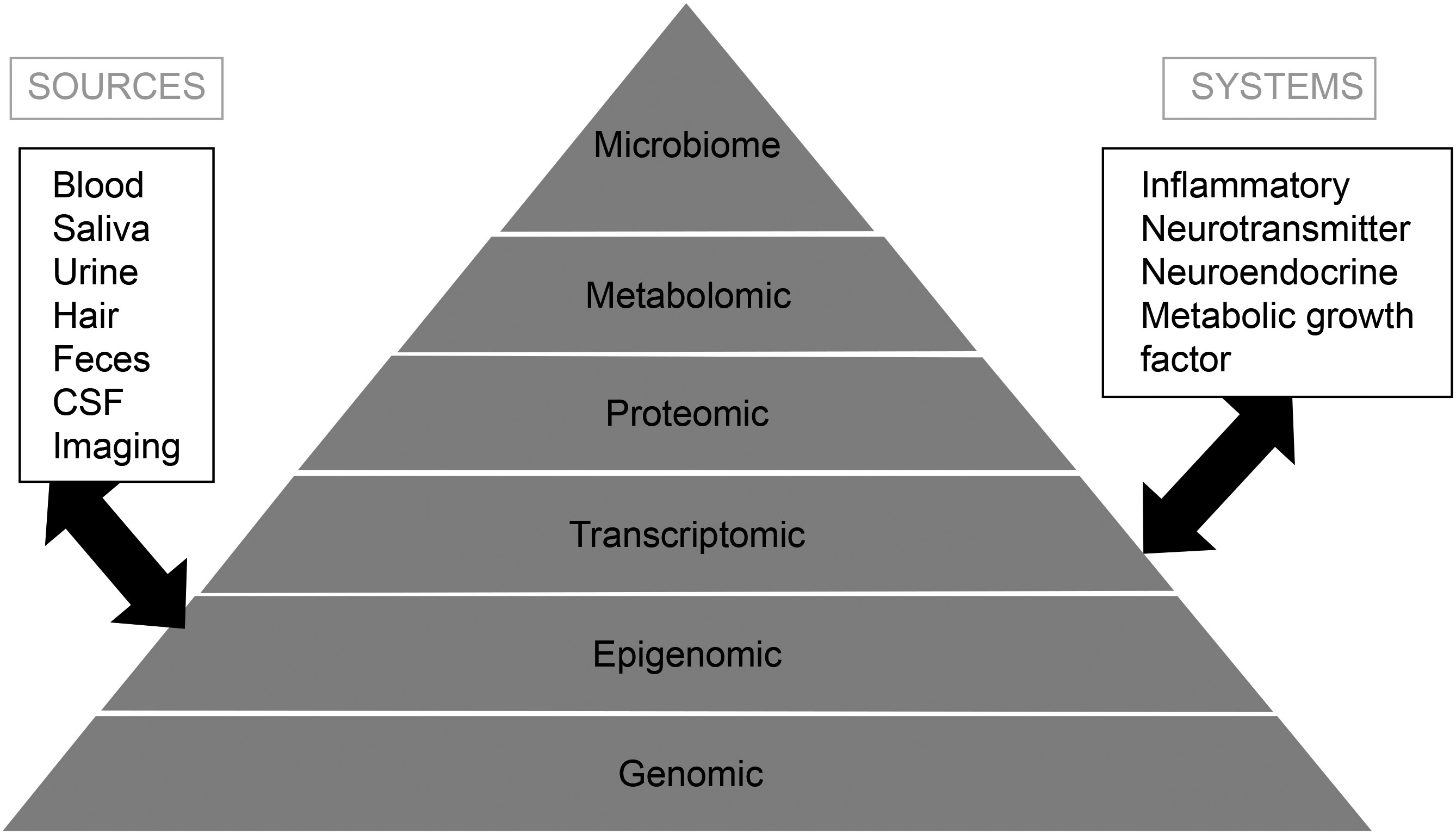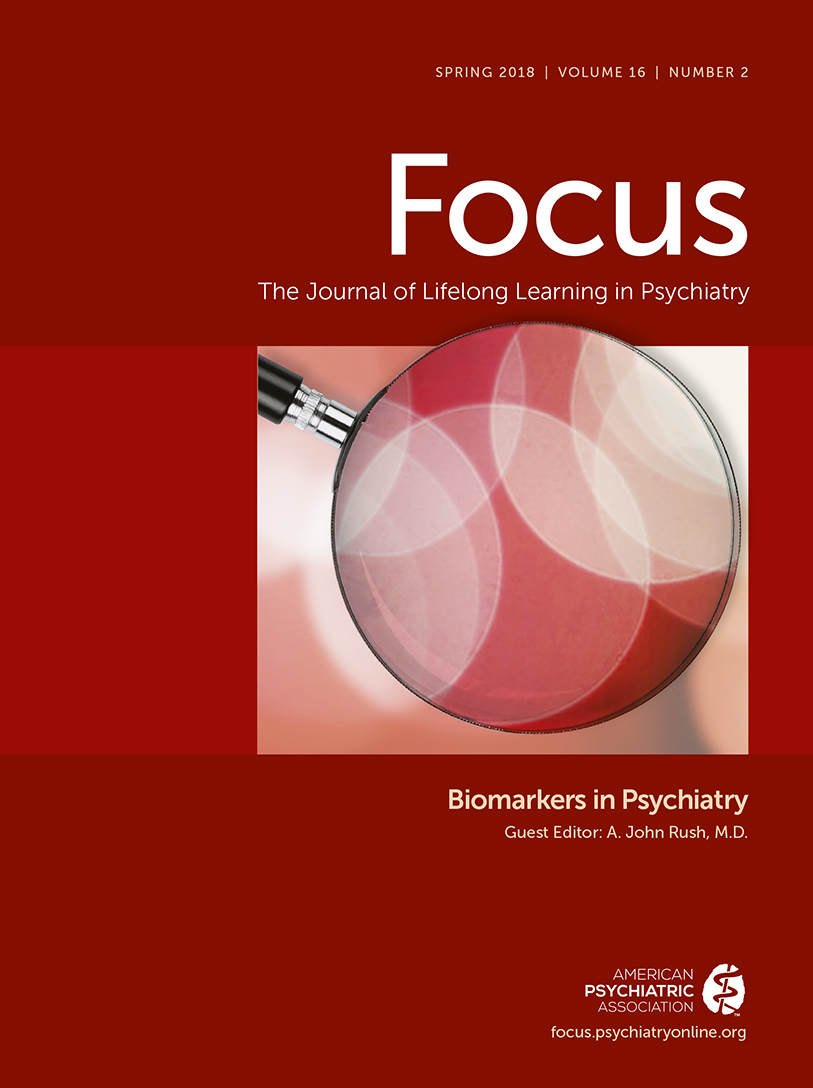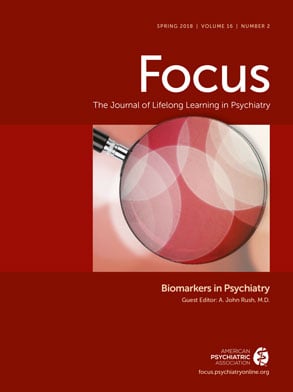Biomarkers for Depression: Recent Insights, Current Challenges and Future Prospects
Abstract
Introduction
Challenges in Mental Health and Mood Disorders
Improving Response to Treatments for Depression
Biomarkers: Systems and Sources

Aims of this Review
Recent Insights
| Biomarker System | Review Topic/Summary | References | Evidence Strength* |
|---|---|---|---|
| Inflammation | Proinflammatory markers are higher in depression than controls | Haapakoski et al40 | Strong |
| Inflammation tends to decrease with antidepressant treatment | Hiles et al50 | Medium | |
| Inflammation seems more aberrant in treatment nonresponders | Strawbridge et al43 | Medium | |
| Anti-inflammatory treatments reduce depression severity | Köhler et al178 | Strong | |
| Neuroendocrine | HPA axis appears overactive in people with depression | Horowitz and Zunszain190 | Strong |
| Atypical depression may show hypocortisolism | Juruena and Cleare191 | Medium | |
| High cortisol may predict a poorer response to psychological therapy and pharmacologic therapy | Fischer et al107 | Medium | |
| Anacker et al108 | |||
| GF | Some neurotrophic factors are reduced in depression compared to controls (BDNF, NGF, GDNF) | Molendijk et al70 | Strong |
| Some GFs may be overproduced in depression (VEGF, bFGF) | Tseng et al77 | Medium | |
| Neurotrophic factors appear to increase alongside treatment, regardless of response | Castrén and Kojima192 | Medium | |
| Neurotransmitter | There is widespread increased 5-HTIA binding in people with depression that can be influenced by treatment | Kaufman et al96 | Strong |
| Monoamines interact to influence cognitive function and responses to stress; may provide mechanisms of TRD | Coplan et al99 | Medium | |
| Metabolic | Depression is associated with altered metabolic profiles | Pan et al193 | Medium |
| The promise of metabolic markers for improving depression treatments is limited by the confounders BMI and severity | Carvalho et al194 | Medium | |
| Atypical depression linked with greater metabolic abnormalities | Lamers et al156 | Strong |
| Source/System | Biomarker(s) with Potential | References |
|---|---|---|
| Inflammation | IL-6, CRP | Haapakoski et al40 |
| TNFα | Strawbridge et al43 | |
| IL-l β | Farooq et al44 | |
| IL-2, IL-4, IL-10, IFNγ | Dowlati et al38 | |
| IL-8, MCPI | Eyre et al39 | |
| IL-1a, IFNα, IL-5, IL-7, IL-12, IL-12p70, IL-13, IL-15, IL-16, IL-17, TNFβ, MCP4, Miplα, Miplβ, SAA sICAMI, sVCAMI, eotaxin, eotaxin3, TARC, IP-10, GM-CSF | Novel markers | |
| Growth factors | BDNF | Molendijk et al70 |
| VEGF | Carvalho et al76 | |
| NGF | Chen et al73 | |
| GDNF | Lin and Tseng74 | |
| IGF-l | Tu et al83 | |
| bFGF, Tie2, sFItl, PIGF, VEGFC, VEGFD, proBDNF | Novel markers | |
| Neurotransmitters | 5-HT and receptors | Kaufman et al96 |
| NA, DA, glutamate/glutamine, GABA, histamine, MHPG, HVA | Coplan et al99 Yoshimura et al197 | |
| Endocrine | Cortisol (various measurements) | Fischer et all07 |
| ACTH, CRH, DHEA, vasopressin | Pierscionek et all98 | |
| TSH | Hage and Azar199 | |
| Metabolic factors | Leptin | Lu88 |
| Ghrelin | Wittekind and Kluge89 | |
| Insulin | Kan et al90 | |
| Albumin | Maes et al93 | |
| Glucose | Lustman et al92 | |
| Lipids | Liu et al91 | |
| Neuroimaging | Structural, for example, gray/white matter volume | Wise et all95 |
| markers | Functional, for example, BOLD; PET ligands assessing various sources | Fu et al29 |
| Genetic | GWAS/polygenic risk | Ripke et al114 |
| Telomere length | Lewis116 | |
| Set of candidate gene polymorphisms; epigenetic changes to DNA (eg, methylation), histone modification; gene expression assessments | Dunn et al200 |
Inflammatory Findings in Depression
Growth Factor Findings in Depression
Metabolic Biomarker Findings in Depression
Neurotransmitter Findings in Depression
Neuroendocrine Findings in Depression
Current Challenges
Biomarker Variability
Stress.
Cognitive Functioning.
Age, Gender and BMI.
Medication.
Heterogeneity
Methodological.
Clinical.
Subtypes within Depression
Biomarker Measurement Challenges
Biomarker selection.
Technology.
Aggregating biomarkers.
Big Data
Future prospects
Biomarker Panel Identification
Discovery of Homogenous Subtypes
Specific Treatment Effects on Inflammation and Response
Prospective Determination of Treatment Response
Toward Stratified Treatments
Novel Treatment Targets
Conclusion
References
Information & Authors
Information
Published In
History
Authors
Metrics & Citations
Metrics
Citations
Export Citations
If you have the appropriate software installed, you can download article citation data to the citation manager of your choice. Simply select your manager software from the list below and click Download.
For more information or tips please see 'Downloading to a citation manager' in the Help menu.
View Options
View options
PDF/EPUB
View PDF/EPUBLogin options
Already a subscriber? Access your subscription through your login credentials or your institution for full access to this article.
Personal login Institutional Login Open Athens loginNot a subscriber?
PsychiatryOnline subscription options offer access to the DSM-5-TR® library, books, journals, CME, and patient resources. This all-in-one virtual library provides psychiatrists and mental health professionals with key resources for diagnosis, treatment, research, and professional development.
Need more help? PsychiatryOnline Customer Service may be reached by emailing [email protected] or by calling 800-368-5777 (in the U.S.) or 703-907-7322 (outside the U.S.).

